On sheep in the Pyrenees
Intelligence
Sheep are born meteorologists. There was the time when Gila was in Spain and the sheep insisted on heading for home, knowing that it was going to snow. And at their current estive Gila and her husband know it is going to rain, even if the sky is clear, when the neighbour’s sheep come over the pass.
“A sheep is lost when it is on its own, but as a flock they are very clever. One of our neighbours changed mountain but the sheep found their way back to the old estive. Without ever having passed there before, they cut across the high mountain slopes to get to their usual pasture.”
Lambing
“Lambing isn’t like in England or Germany, in the natural season, in spring. In all the Pyrenees lambing takes place in autumn in the valleys. It’s too dangerous up there in the estive, even in summer. If it is cold, the mothers get udder infections or the lambs may die. If it isn’t the cold, it’s the heat. The lambs dehydrate very quickly up there because there is no shade, the sun is deadly. The mother goes away to graze, leaving her lamb. When she returns in the evening it is dead.”
But if the farmer miscalculates, some lambs may be born in the estive.
Saturday 25 August [She is rounding up the sheep to get them to go up higher] I send Shamboo into the Coume. A ewe attacks him. I recall him and go myself. A new-born lamb. Wrong place. I look at him admiringly and then he starts to suckle. I am filled with joy for this morning’s gift. I take the little one and his mother up the slope. When we finally arrive at the top it is 11h30. I put the little one next to his mother and the animals come to sniff this Titon – an unforgettable scene.
“I couldn’t use the dog anymore, because the mothers will charge a dog. Viciously. They are fearless.”
So it was slow work to bring the sheep, the lambs and the dogs off the mountain when finally the time came.
Sicknesses
In her first year in the estive on her own, Gila told me, something happened that even the old shepherds didn’t know much about. The spotted flesh fly (Wohlfahrtia magnifica) came back. From that year onwards it has always been present.
Sunday [29 July, with Max, a farmer, and Christine] What a massacre. The maggots are disgusting. Firstly we treat one of Jean’s animals. I cut off the rotten flesh, I dig, dig to extract these shameless parasitic bugs. Then I continue with the feet. I don’t understand what is happening with the feet. They are rotting and the fat white maggots are digging deeper. I feel sick, want to wash myself.
“My work was to search the patches of snow to find the sheep who had hidden themselves there because of that,” Gila explained. “When they have maggots they almost go mad; they itch all the time. They stop eating properly. They seek out cool places so I had to extract the sheep so that I could treat them. The fly seeks out anything which smells – wounds, the foreskin of the ram – and the larvae grow quickly. You have to extract them with tweezers and then treat the area.”
Piétin (foot rot)
“On Sundays I would bring all the sheep together to examine them and treat any problems. In the high mountains, mostly it is animals that are limping because of foot rot. It is a microbe which attacks when the hooves have not been trimmed. It can go a long way, destroying the hoof.”
Thursday 23 August. I must make some bandages. Here, there is not enough cloth so I tear up the arms of Peter’s shirt that I like so much. Jean’s sheep are limping terribly and those I can catch are in a bad way. Blood and foot rot. Maggots again.
Heat and cold
Sheep don’t much like heat. “That’s why, when it is good weather, you hardly see them. As soon as the sun comes out they want to hide. If there isn’t any shade to be had they will put their heads together and hide them. You can’t make them move. It’s very funny.”
Left to themselves, the sheep would decide where to go early in the morning. “You have to get there just before sunrise. The sheep start to move the moment the sun arrives. They will start to eat straight away and if it is fine, in summer, at 9 o’clock they have finished. The sun is too strong and they will go somewhere to put their heads in the shade. They don’t eat between 9 am and 4 pm. They hide – when it is fine. If it’s foggy they will eat all day long. Otherwise they will only start again at 4 pm.”
Salt
“You have to put salt on large flat stones around your hut so that everyone gets her salt. It’s the moment when you see everyone together. I loved that moment, being together.”
It is also the moment to pass through the flock, looking at each sheep, checking for problems. At that time there were none of today’s metal enclosures which facilitate the task of checking the sheep.
“One day the sheep got into my rocky corral – my nest – in Spain where I kept my food hidden in holes in the rocks. They unearthed everything. When I got back one of them still had the last packet of dried soup poking out of her mouth. She was chewing her way through the plastic to get at the salt inside.”


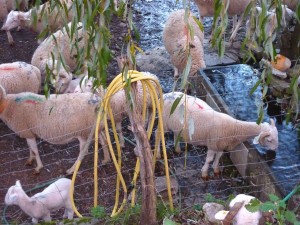
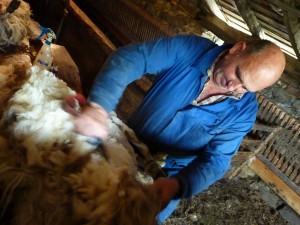
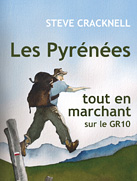
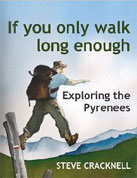

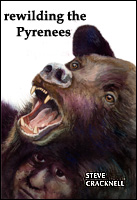



Footprints on the mountains